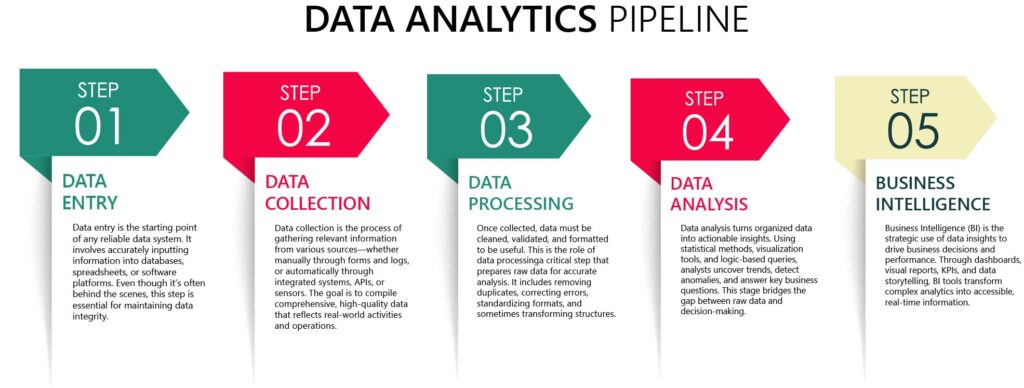
Importance of Business Intelligence
Importance of Business Intelligence
Business Intelligence (BI) is the final and most impactful stage of the data analytics pipeline. While data collection, processing, and analysis lay the foundation, BI brings everything together by transforming insights into clear, actionable strategies. Tools like Power BI, Tableau, and other BI platforms allow organizations to visualize data in real time, making it easier for decision-makers to identify opportunities, mitigate risks, and track performance.
The true value of BI lies in accessibility. It democratizes data by putting dashboards and visual reports in the hands of executives, managers, and frontline employees alike, ensuring decisions are informed by facts rather than guesswork. Companies that embrace BI gain a competitive edge, because they can move faster, adapt to change, and measure success with precision.
In the modern business landscape, data is everywhere. From customer interactions and sales transactions to inventory management and employee performance, organizations are constantly generating information. But raw data alone doesn’t hold value, it needs to be structured, processed, and analyzed to become actionable.
Business Intelligence is not the end of the pipeline but rather the beginning of smarter decision-making. It closes the loop by connecting raw data to strategic outcomes, helping organizations stay agile in today’s fast-paced, data-driven world.
Smarter Decision-Making
With Business Intelligence, decision-making shifts from reactive to proactive. Instead of relying on intuition or outdated reports that may not reflect current realities, leaders can access real-time dashboards and customized reports tailored to their specific needs.
For example, a sales manager can immediately see which products are underperforming, which regions are exceeding targets, and where customer churn is highest all in a single dashboard. This allows for course corrections in real-time rather than waiting until the end of a quarter when opportunities may already be lost.
BI also promotes evidence-based strategies. Instead of debating assumptions, leadership teams can reference a single source of truth. Metrics like customer lifetime value, operational efficiency ratios, and campaign ROI can be broken down by segment, time, or region. This depth of insight helps organizations not only answer “what is happening” but also uncover why it is happening and predict what is likely to happen next.
The result is faster, more confident decisions that align resources with opportunities. A marketing director can reallocate budget mid-campaign if data shows certain channels outperforming others. A supply chain manager can anticipate shortages before they cause delays. And executives can steer the business toward growth with far less uncertainty.
In short, BI doesn’t just inform decisions it transforms them. Leaders move from making choices based on gut feelings to building strategies rooted in facts, trends, and predictive analytics.
Increased Efficiency and Productivity
One of the biggest advantages of Business Intelligence is the way it eliminates bottlenecks in data management. Instead of employees spending hours gathering, cleaning, and formatting spreadsheets, BI tools automate these tasks and refresh dashboards in real time. This ensures teams always have the latest numbers without the manual hassle.
But efficiency is only half the story. Productivity rises because people can shift their energy toward higher-value activities analyzing trends, developing strategies, or addressing customer needs rather than wrestling with data preparation. In other words, BI doesn’t just save time; it transforms how that time is used.
For leadership, this means quicker access to actionable insights. For employees, it means a more streamlined workflow and the ability to focus on meaningful contributions. The combined effect is a workplace that runs leaner, faster, and smarter, ultimately boosting both organizational performance and employee satisfaction.
Data Transparency
A robust Business Intelligence system does more than display metrics it creates a single source of truth for the entire organization. When everyone, from executives to team leaders, accesses the same verified data, there’s less room for misinterpretation or conflicting reports. This consistency builds trust in the numbers and ensures that discussions and decisions are grounded in fact rather than assumption.
Data transparency begins at the foundation of the analytics pipeline. Accurate data entry ensures that the information entering the system is correct. Effective data collection guarantees that all relevant data points are captured, and thorough data processing organizes and cleans that information. Finally, precise data analysis highlights trends and outliers. BI ties all these stages together, presenting the processed insights in a clear, accessible way that everyone can understand and act on.
Transparency also enhances cross-departmental collaboration. Marketing, sales, operations, and finance teams can align around shared goals because they’re all working with the same metrics. A product launch, for instance, can be coordinated seamlessly when everyone sees real-time updates on inventory, sales forecasts, and campaign performance in one centralized dashboard.
Moreover, a transparent BI system promotes accountability. When key performance indicators are visible to relevant stakeholders, it’s easier to identify successes, pinpoint bottlenecks, and adjust strategies quickly. The result is an organization where decisions are not siloed, communication is clearer, and teams can respond faster to changes in the market or business environment.
Competitive Advantage
Business Intelligence doesn’t just improve internal processes it can become a strategic differentiator in the marketplace. Organizations that leverage BI effectively gain insights faster than competitors, spot emerging trends before they become obvious, and can pivot strategies based on real-time information rather than assumptions.
By combining accurate data from the analytics pipeline with BI tools, companies can anticipate customer needs, optimize operations, and identify new opportunities. For example, sales teams can focus on high-potential leads, marketing can target campaigns more precisely, and supply chain managers can adjust inventory to meet demand before shortages occur.
Ultimately, BI transforms information into action. It allows businesses to make faster, smarter decisions, reduce risk, and capitalize on opportunities that competitors may overlook. Companies that embrace BI don’t just react to the market, they actively shape it, giving them a sustainable edge and stronger growth potential over the long term.
Bringing It All Together
The journey from raw data to actionable insight is a pipeline, and each stage builds on the last. It begins with a skilled data entry associate, ensuring accurate information is entered into systems. Next, data collection captures the right inputs, followed by data processing, which organizes and cleans the information. Data analysis transforms that organized data into meaningful insights, and Business Intelligence brings it all together providing transparency, improving efficiency, and giving organizations a competitive edge.
When every step of the pipeline is executed thoughtfully, businesses gain more than just information they gain clarity, confidence, and the ability to act strategically. BI ensures that decisions are data-driven, risks are mitigated, and opportunities are captured in real time.
In today’s fast-paced, data-rich environment, organizations that invest in a full analytics pipeline are the ones that can adapt, innovate, and thrive. From the first keystroke of data entry to the dashboards guiding executive decisions, each link in the chain matters and together, they create a foundation for smarter, more impactful business decisions.
